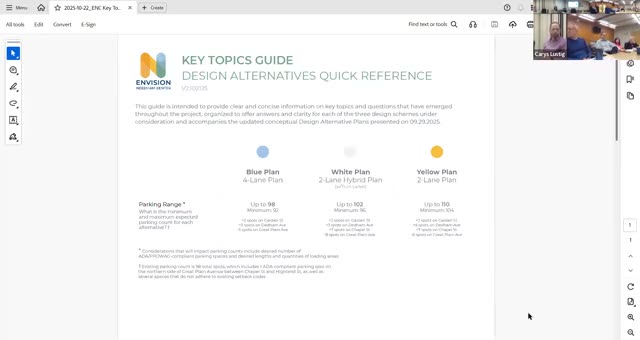Needham group explores curbside management and delivery loading zones for downtown
October 23, 2025 | Town of Needham, Norfolk County, Massachusetts
This article was created by AI summarizing key points discussed. AI makes mistakes, so for full details and context, please refer to the video of the full meeting. Please report any errors so we can fix them. Report an error »

During its Oct. 22 meeting the Envision Needham Center working group reviewed curbside management and loading‑zone options for Great Plain Avenue, discussing enforcement, delivery behavior and flexible striping as near‑term tools.
Consultants and staff explained that trucks are generally not supposed to load in the public right of way under current zoning rules, and that Needham has limited precedent for curbside management beyond pandemic-era measures. Members said that signature curbside changes should be flexible: loading zones can be implemented by striping and later moved if they prove ineffective.
Project consultants described alternatives used by other towns: time-of-day loading zones, short-term express parking (for 15‑minute pickups), or conversion of underused spaces during off-peak hours. Staff noted the need for a clearer inventory of which businesses have alley access or private loading areas and where on-street delivery is truly necessary.
Several delivery drivers reportedly told a working-group member that they would not adhere to loading‑zone times if doing so conflicts with their schedules; the group acknowledged enforcement challenges and the risk that dedicated loading zones go unused. Members said monitoring actual behavior during peak times would help determine which curbside policies are practical.
Committee discussion also touched on winter maintenance: removed snow often piles in on‑street stalls and can complicate loading and temporary zones; staff described a process of “punch-out” or full snow removal 24 to 48 hours after large storms, but also warned that wet, freeze‑thaw conditions can make removal difficult.
The working group asked project staff to research curbside-management examples from neighboring communities, and to identify candidate loading‑zone locations that could be implemented as striped (non‑permanent) spaces and later adjusted if data show they are unused.
Consultants and staff explained that trucks are generally not supposed to load in the public right of way under current zoning rules, and that Needham has limited precedent for curbside management beyond pandemic-era measures. Members said that signature curbside changes should be flexible: loading zones can be implemented by striping and later moved if they prove ineffective.
Project consultants described alternatives used by other towns: time-of-day loading zones, short-term express parking (for 15‑minute pickups), or conversion of underused spaces during off-peak hours. Staff noted the need for a clearer inventory of which businesses have alley access or private loading areas and where on-street delivery is truly necessary.
Several delivery drivers reportedly told a working-group member that they would not adhere to loading‑zone times if doing so conflicts with their schedules; the group acknowledged enforcement challenges and the risk that dedicated loading zones go unused. Members said monitoring actual behavior during peak times would help determine which curbside policies are practical.
Committee discussion also touched on winter maintenance: removed snow often piles in on‑street stalls and can complicate loading and temporary zones; staff described a process of “punch-out” or full snow removal 24 to 48 hours after large storms, but also warned that wet, freeze‑thaw conditions can make removal difficult.
The working group asked project staff to research curbside-management examples from neighboring communities, and to identify candidate loading‑zone locations that could be implemented as striped (non‑permanent) spaces and later adjusted if data show they are unused.
View full meeting
This article is based on a recent meeting—watch the full video and explore the complete transcript for deeper insights into the discussion.
View full meeting
